Janelle Monáe's Ready to Burn Sh*t Down

All eyes are on Janelle Monáe as she walks into a swanky restaurant in uptown Manhattan. Punctuating her black-and-white ensemble is a pair of tiny, very on-trend sunglasses; these, however, have a lens for the third eye attached at the top (not unlike the ones her idol Prince wore once upon a time). The glasses match her black Kenzo sweater, which features an all-over eye print. Who’s watching whom?
For lunch she orders avocado toast, fresh-squeezed orange juice, and a dozen oysters to share. She asks a few questions to figure out my background, her mind calibrating itself in real time, calculating how the interview will go before it has even begun. When she is satisfied, she says, “OK, what do you want to talk about?”
VIDEO: How to be a Badass Woman featuring Janelle Monáe
In a way Janelle Monáe, 33, was born with a heightened sense of awareness. The Kansas City, Kan., native comes from a large religious family (“I have 50 cousins. Five-zero!”) and was primarily raised by her mom — a janitor — and her grandmother, who ran a de facto community center out of her home that was filled with kids, ex-convicts, and recovering addicts. During this time Monáe was performing in plays and talent shows, and after she graduated from high school, she decided to attend the American Musical and Dramatic Academy in N.Y.C. to study acting and music. After almost two years she packed up again and moved to Atlanta, where she offset playing college campuses by working at Office Depot. Eventually, her act caught the eye of OutKast’s Big Boi and then one Sean “Diddy” Combs. Her début EP, Metropolis, released on the latter’s Bad Boy label, was the first of three concept records based on the tale of her alter ego, Cindi Mayweather, an android running from the law after falling in love with a human.
With a knack for storytelling, Monáe broke into the scene as a fully formed artist. In the beginning she always was outfitted in a black-and-white tuxedo, a nod to the uniforms worn by her working-class parents. It was also her way of rebuking gender politics.
“I’ve always wanted to redefine what a cool young black woman looks like in the music industry,” says Monáe with a sigh. “I was never interested in fitting into a system that wasn’t built for me or with me in mind. I’m interested in burning that shit down and building something new.”
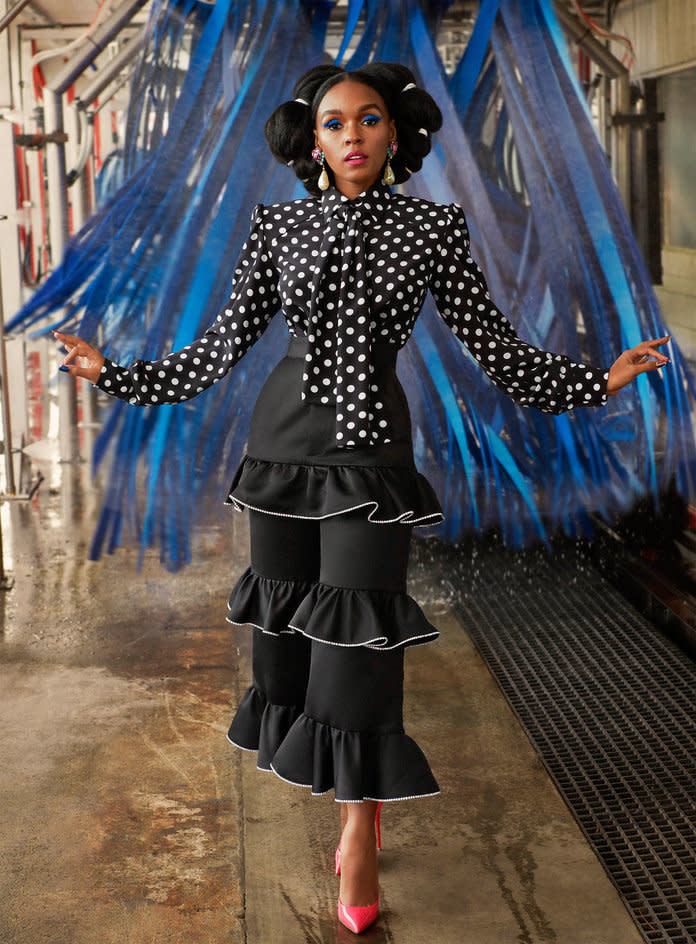
Monáe in a Dolce & Gabbana blouse and earrings, Area pants, and Christian Louboutin pumps. Photographed by Pamela Hanson.
A decade of critically acclaimed albums gave way to critically acclaimed performances in critically acclaimed movies like 2016’s Moonlight and Hidden Figures. In November Monáe will appear in the Harriet Tubman biopic Harriet, as Marie Buchanon, a free black woman and business owner who teaches Tubman to embrace her freedom. Then she’ll portray Dorothy Pitman Hughes — who co-founded Ms. magazine along with Gloria Steinem, played by Julianne Moore — in The Glorias: A Life on the Road, based on the feminist icon’s autobiography. It’s obvious that Monáe’s choice of movies has been very deliberate — most of them tell the stories of underdogs, of people who have been written out of history, whether they took part in big cultural triumphs or small personal ones.
“I don’t look at myself as just an actor or a musician,” she says. “I am an artist, and I have a responsibility to tell the truth. I use different mediums, but it’s all storytelling to me.”
Her overall aim, she says, was never to be famous but rather “to add value to the culture.” With the release of last year’s Dirty Computer, her typical new-album nerves were heightened by personal revelations that opened her up to a whole other world of cultural sensitivities. Her music video for “Make Me Feel” found Monáe in a chain-mail bikini top and matching trousers, doing a sort of push-and-pull choreography with both a man and the actress Tessa Thompson. It was immediately crowned a “bisexual anthem” and fueled speculation about her and Thompson, whom Monáe was rumored to have been dating as far back as 2015. The release of another music video, for the song “Pynk,” found Monáe once again in the company of Thompson, but this time the singer was wearing giant pink pants in the shape of a vagina.
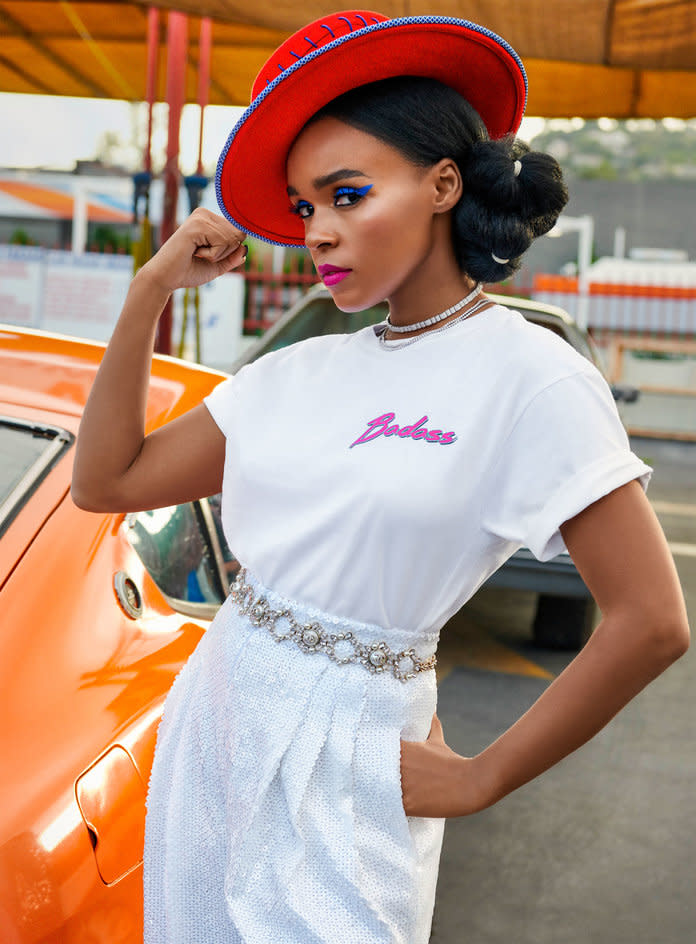
Monáe in an InStyle x karla T-shirt ($40), Chanel pants and belt, a Ruslan Baginskiy hat, a Shay Jewelry and a Jennifer Meyer necklace. Photographed by Pamela Hanson.
“One of the things that bothered me before I did Dirty Computer was this concept of respectability politics, men and women who don’t respect agency and think that if we dress a certain way, if we show skin, we’re seeking attention,” says Monáe. “I don’t want your attention. I’m exercising my freedom.”
When it came to wearing the proverbial pants, she was all about having fun. Even bringing up the topic makes her break out into a huge smile. “I knew I wanted women, especially black women, to be shown experiencing joy and celebrating each other,” she says. “People get really giggly when we come onstage. It’s important that we laugh.”
Monáe had always made allusions to queer love in her music, but with Dirty Computer there was no longer ambiguity. Following its release, she came out as pansexual in an interview with RollingStone, confirming that she was no longer telling Cindi Mayweather’s story but rather her own. A weight had been lifted, though not being able to hide behind a character came with its own set of problems.
“The majority of [my family] grew up Baptist, and the sermons would all be around how if you are a homosexual or if you’re gay and you don’t repent and live a hetero-normative life and get married, well … hell is your final destination,” says Monáe. “I talked to my mom and dad first, and my mom, in particular, had a lot of questions. I said, ‘Mama, the only way that I can create art is to truthfully tell my story. It has to come from an honest place, and this is who I honestly am. I don’t know any other way. I have to talk about my sexuality. I have to talk about my blackness. I have to talk about my womanness. I have to talk about these things. This is who I am as a person.’ ”
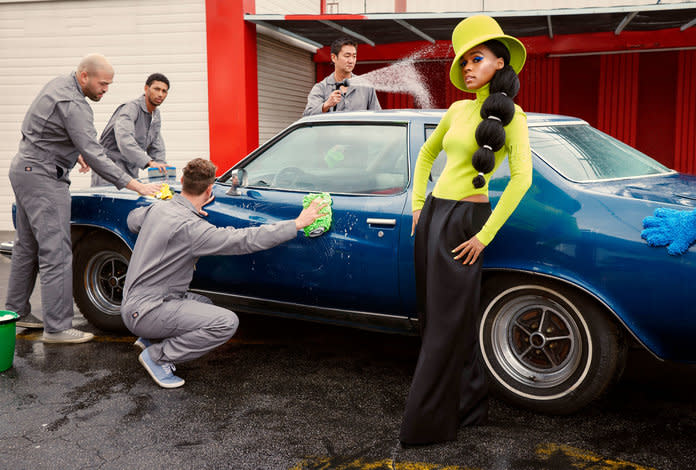
Monáe in a Nina Ricci bodysuit, trousers, and hat. Photographed by Pamela Hanson.
Though she admits that not everyone in her extended family has fully embraced her coming out, Monáe is not holding grudges. (Her mom, meanwhile, has become her staunchest defender back in Kansas City, telling prying relatives, “I don’t want to have to slap a fool, but I will over my daughter.”) She’s even getting accustomed to a whole new host of questions about her sexuality, mainly whom she is dating. “I’m a very private person, so I’ve been trying to navigate the space of talking about identity without disclosing that information,” says Monáe. “We’re in a culture where people obsess and obsess over those sorts of things. And I get it.”
When asked about what brings her pleasure, Monáe is less coy. “Masturbation,” she says matter-of-factly. Though it may seem like an attention-grabbing statement, it is rooted in practicality. “I have been in situations where as a young girl you have compromised your morals and your values and you feel used,” she says. “And I’m like, ‘If my mother had let me have a vibrator at a young age to be in touch with my body more, I could have saved myself from so many poor decisions.’ You know what I’m saying?”
Dirty Computer was not only freeing in the obvious way. A self-professed perfectionist, Monáe has since started embracing her mistakes and imperfections. The things that make her, you know, human. “When I first came up with the motto ‘Embrace what makes you unique, even if it makes others uncomfortable,’ I should have added, ‘even if yourself is the other,’ ” she says. “At the time I would say it, but I really didn’t mean it.
"Embracing your uniqueness is an active choice," she continues. "I don’t wake up looking flawless every morning. I don’t wake up feeling empowered. I don’t wake up feeling fearless. I have to actively choose to feel that way.” She adds with a laugh, "I’m like Issa Rae in Insecure, like, ‘Bitch, keep it together!'"
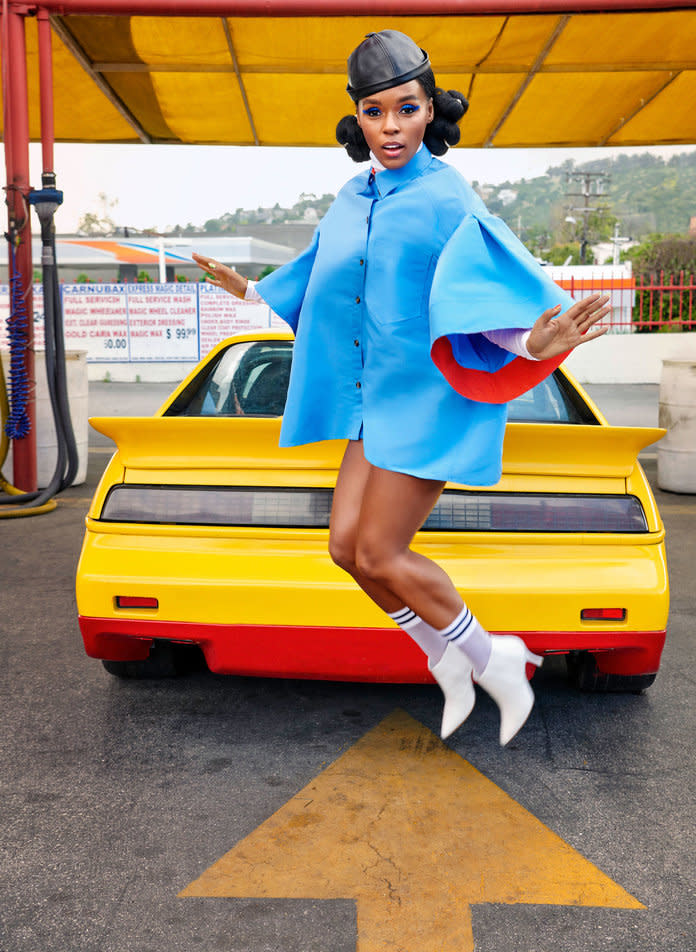
Monáe in a Carolina Herrera shirt, a Wolford bodysuit, a Louis Vuitton hat, Forever 21 socks, and Manolo Blahnik boots. Photographed by Pamela Hanson.
So, when does she actually feel powerful?
Monáe thinks for a second. “That’s a tricky question because power dynamics do exist. For example, if I walk in [a room] and I’m the only black woman in a room of white folks and they are making decisions, there is a power dynamic there where I feel like I may have to assert myself more, or I may be a little uncomfortable, depending on what’s on the table for me to own. That used to intimidate me, but now when I walk in, I realize that I am an important piece of the puzzle. My ideas matter. What I have to create has the potential to shape the world, to change the narrative, to be more inclusive.”
With her emboldened sense of self, Monáe is ready to develop more projects through her production company, Wondaland Pictures. She wants to direct and plans to take filmmaking courses, and she’s super-excited to realize some of her ideas as a writer. In addition, she’s keen to explore new modes of communication beyond her own brand of intergalactic slanguage. “I speak android, which is helpful for the future, since we will be merging.” Pause. “But I really want to be fluent in French.”
Uninhibited and unafraid, she says that auditions no longer make her anxious, but her nerves do manifest in other, entirely relatable ways. “I get nervous at the thought of giving birth,” she says. “I haven’t had a child yet, and I think the Internet makes everything feel like the worst can happen. Then, in actuality, it is true for black women — they have such a high mortality rate when they’re giving birth.
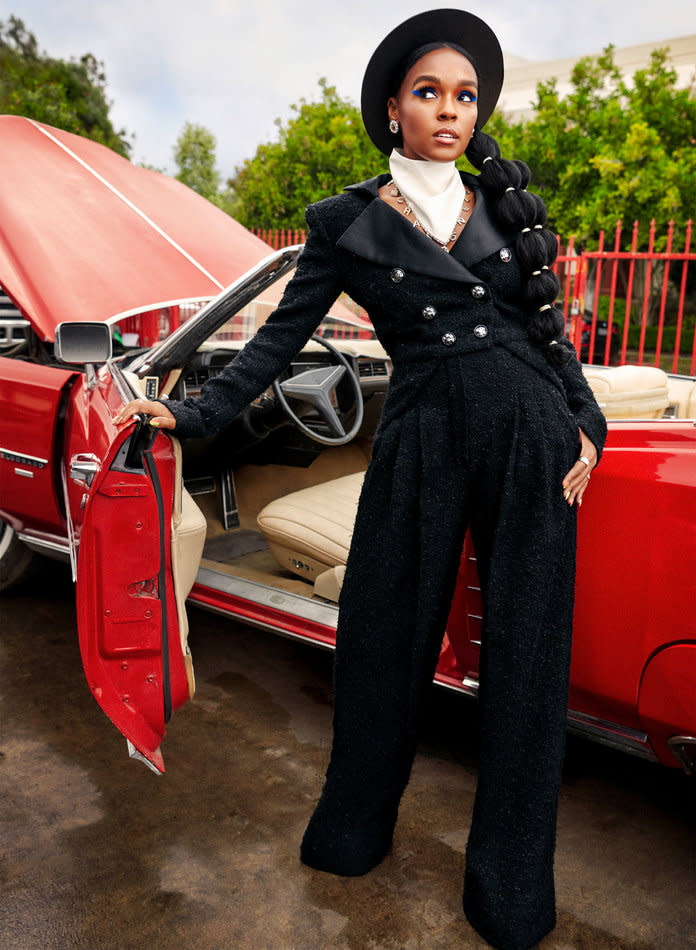
Monáe in a Chanel jacket, pants, earrings, and scarf and Chanel Fine Jewelry rings. Hat, her own. Photographed by Pamela Hanson.
“[Having a baby] is like a science-fiction movie,” she adds. “It’s miraculous. My grandmother had 12 kids, and I heard she went to work the next day after she had one of my aunts. I come from that woman, you know? If she can do that, you know I can take it to the next level.”
To Monáe, it’s all connected — music, film, art, sex, babies. The all-knowing third eye is always on watch. She tells a story of being overcome with emotion at the sight of a color-changing star one night after a concert in Palm Springs. The sky was clear, and Monáe watched as what she perceived to be Sirius flickered from red to green to blue. She started crying, awed by its magnificence.
“That was the only time I’ve been starstruck,” she says with a laugh. “Literally. But it just made me realize that me and the universe are cool, you know? I’m at peace with what it gives me.”
Photographed by Pamela Hanson. Styling: Julia von Boehm. Hair: Nikki Nelms. Makeup: Jessica Smalls. Manicure: Sreyin Peng. Production: Avenue B.
For more stories like this, pick up the August issue of InStyle, available on newsstands, on Amazon, and for digital download July 19.

